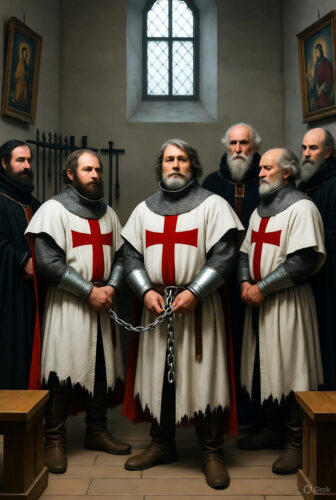Imagine waking up to the clatter of armored boots storming your door, your life’s work crumbling in an instant under false accusations, all because a king needed your gold more than your loyalty. On October 13, 1307—a crisp autumn Friday that would forever taint the number 13 with superstition—King Philip IV of France unleashed a meticulously planned assault on one of the most powerful organizations in medieval Europe: the Knights Templar. This wasn’t just an arrest; it was the beginning of the end for a brotherhood that had risen from humble pilgrims’ protectors to international bankers and warriors extraordinaire. In this deep dive, we’ll unravel the intricate tapestry of their history, from glorious crusades to ignominious trials, packing in the juicy details that make history feel like a blockbuster thriller. And stick around—because we’ll distill this medieval drama into actionable wisdom that could supercharge your life today, turning potential pitfalls into personal triumphs.
### The Humble Beginnings: From Pilgrims’ Guardians to Holy Warriors
To understand the cataclysmic events of October 13, 1307, we must journey back nearly two centuries to the chaotic aftermath of the First Crusade. In 1099, Christian forces captured Jerusalem, fulfilling a papal call to reclaim the Holy Land from Muslim control. But victory brought new perils: roads teeming with bandits preying on pilgrims flocking to sacred sites. Enter Hugues de Payens, a French knight disillusioned by the violence, who in 1119 gathered eight like-minded comrades to form a protective order. They dubbed themselves the “Poor Fellow-Soldiers of Christ and of the Temple of Solomon,” vowing poverty, chastity, and obedience while basing themselves in the ruins of Solomon’s Temple—hence the shorthand “Templars.”
Their early days were anything but glamorous. Living off alms, they patrolled dusty paths in tattered tunics, their white mantles emblazoned with a red cross symbolizing martyrdom. But word spread quickly. At the Council of Troyes in 1129, endorsed by the influential Bernard of Clairvaux—a Cistercian abbot whose writings framed them as “knights of Christ”—the Templars received official papal approval. Bernard’s treatise, “In Praise of the New Knighthood,” painted them as a divine fusion of monk and warrior: “He is truly a fearless knight and secure on every side, for his soul is protected by the armor of faith just as his body is protected by armor of steel.”
This endorsement ignited explosive growth. Donations poured in—lands, castles, and funds from nobles eager for spiritual merit. By the 1130s, the order had chapters across Europe, from England to Portugal. Their rule, modeled on Cistercian monasticism but adapted for combat, included 72 clauses governing everything from meals (meat thrice weekly) to warfare (no retreating unless outnumbered three-to-one). Knights were the elite fighters, sergeants handled logistics, and chaplains provided spiritual guidance. Women were barred, but associates like confraters donated without full vows.
The Templars’ military prowess shone in the Second Crusade (1147–1149). Under Grand Master Everard des Barres, they coordinated with King Louis VII of France, their disciplined charges turning the tide at battles like the Siege of Damascus. Though the crusade failed, their reputation soared. They built formidable fortresses like Krak des Chevaliers in Syria, a masterpiece of concentric design with towers, moats, and provisions for sieges lasting years. These strongholds weren’t just defensive; they were economic hubs, farming vast estates to fund operations.
### Ascendancy and Innovation: The Templars as Medieval Power Brokers
By the mid-12th century, the Templars had evolved into a multinational powerhouse. Their network spanned from the British Isles to the Levant, with over 1,000 commanderies—self-sustaining farms and preceptories. In Paris, their headquarters, the Temple, was a fortified complex rivaling royal palaces, complete with towers and a chapel modeled on the Holy Sepulchre. They amassed wealth through savvy management: exemptions from taxes (thanks to papal bulls like Omne Datum Optimum in 1139) allowed them to undercut competitors.
But their real genius lay in finance. Pilgrims faced dangers carrying cash, so Templars invented an early banking system. A traveler could deposit funds at a European preceptory and withdraw equivalent amounts in the Holy Land using encoded letters of credit—precursors to modern checks. They loaned to kings and popes, charging interest disguised as “gifts” to skirt usury bans. By 1200, they managed treasuries for figures like Henry II of England, who stored his wealth in their vaults during rebellions.
Militarily, they were legends. During the Third Crusade (1189–1192), under Grand Master Robert de Sablé, they fought alongside Richard the Lionheart at Arsuf, their heavy cavalry smashing Saladin’s forces. Saladin himself respected them, once ransoming a Templar knight for a hefty sum. Yet defeats mounted: the disastrous Battle of Hattin in 1187 saw Grand Master Gerard de Ridefort captured and executed, Jerusalem lost. Undeterred, Templars relocated to Acre, spearheading reconquests.
Their influence bred envy. Rumors swirled—of secret rituals, immense treasures hidden in crypts. They answered only to the Pope, irking secular rulers. In Cyprus, acquired after Acre’s fall in 1291, they governed like a state, minting coins and negotiating treaties. Jacques de Molay, elected Grand Master in 1292, was a Burgundian veteran of Acre’s siege. Charismatic and devout, he lobbied for new crusades, traveling Europe to rally support. Little did he know, his order’s apex masked gathering storm clouds.
### Storm Clouds Gather: The Loss of the Holy Land and Internal Strains
The fall of Acre in 1291 marked a turning point. The last major Crusader stronghold crumbled under Mamluk assault, with Templars fighting to the last in their seaside tower. Survivors fled to Cyprus, their purpose questioned. Without the Holy Land, were they obsolete? De Molay proposed merging with the Hospitallers, but rivalries—Hospitallers focused on healing, Templars on combat—stymied it.
Europe changed too. Nationalism rose; centralized monarchies like France’s chafed at independent orders. Philip IV, “the Fair,” ascended in 1285 amid fiscal woes. Wars with England drained coffers; he debased currency, earning the nickname “the Counterfeiter King.” Conflicts with Pope Boniface VIII over taxation culminated in the 1303 Anagni outrage, where Philip’s agents assaulted the Pope, leading to his death.
Philip eyed the Templars’ wealth—estimated at millions in gold, vast lands. Rumors of heresy, fueled by expelled members like Esquiu de Floyran, provided pretext. Accusations included denying Christ, spitting on crosses during initiations, idol worship (a “head” called Baphomet), and sodomy—sensational claims blending truth (secret rites) with fabrication.
Pope Clement V, elected in 1305 under French influence, was Philip’s puppet. Born Bertrand de Got, he moved the papacy to Avignon, beginning the “Babylonian Captivity.” Initially reluctant, Clement summoned de Molay to France in 1306 for discussions. De Molay arrived in Poitiers, unaware of the trap.
### The King’s Machinations: Debt, Power, and the Plot Unfolds
Philip’s motives were clear: debt. He owed Templars vast sums from loans for his wars. Seizing their assets would refill treasuries and eliminate creditors. In September 1307, he issued secret orders to bailiffs: arrest all Templars at dawn on October 13, seize properties. The warrant listed crimes: heresy, idolatry, obscenity.
Why Friday the 13th? Practicality—coordinated strikes required surprise. Templars, though warriors, were scattered, many elderly or administrative. Philip consulted lawyers like Guillaume de Nogaret, mastermind of Anagni, to justify actions.
Clement, informed post-facto, protested but weakly. Philip pressured him, threatening schism. By October 22, Clement ordered arrests elsewhere, but few complied—England’s Edward II delayed, Scotland ignored.
### The Fateful Day: Dawn Raids Across France
October 13, 1307, dawned cold and fateful. In Paris, royal agents stormed the Temple before sunrise. De Molay, roused from sleep, was chained alongside 137 brethren. Across France, 625 Templars were captured—from preceptories in Normandy to Provence. Some resisted; in Paris, a few drew swords but were overwhelmed.
The surprise was total. Templars, trusting their papal immunity, hadn’t anticipated betrayal. Properties were inventoried: gold, jewels, archives. Philip claimed it for “safekeeping.” De Molay was imprisoned in Chinon Castle, interrogated immediately.
News spread like wildfire. In London, Edward II dismissed accusations as “incredible,” but pressure mounted. In Aragon, Templars fortified castles, holding out until 1308.
### The Grueling Trials: Torture, Confessions, and Papal Capitulation
Trials began October 19 in Paris. Inquisitors, led by Dominican William of Paris, used torture—racks, strappado, fire—to extract confessions. De Molay admitted under duress to denying Christ in initiations, claiming it tested resolve. Thirty-six died from torture; others recanted later.
Public spectacle followed: on October 25, de Molay confessed before University of Paris scholars. Clement suspended the Inquisition in November, but Philip reconvened it. In 1308, 72 Templars “confessed” before Clement in Poitiers.
The Pope dithered. In 1310, a council in Sens saw Archbishop Philip de Marigny—Philip’s half-brother—burn 54 relapsed Templars. De Molay retracted his confession, demanding papal audience.
At the Council of Vienne (1311–1312), Clement suppressed the order via bull Vox in Excelso, citing scandal, not guilt. Assets transferred to Hospitallers, but Philip skimmed much.
### Aftermath and Legacy: Flames, Curses, and Enduring Mysteries
On March 18, 1314, de Molay and Geoffroi de Charney were burned in Paris. Legend says de Molay cursed Philip and Clement, summoning them before God within a year—both died soon after. Templars scattered: some joined other orders, others fled to Scotland or Portugal (where they became the Order of Christ).
The order’s fall reshaped Europe: centralized power strengthened, crusading zeal waned. Myths proliferated—hidden treasures, Holy Grail links—fueling modern lore like Freemasonry ties.
### Echoes in Today: Turning Templar Trials into Personal Triumphs
The Templars’ saga isn’t just dusty history—it’s a masterclass in navigating power’s perils. Their downfall from untouchable elites to persecuted outcasts teaches vigilance, adaptability, and integrity. Here’s how you can benefit today, applying these lessons to forge a more resilient life:
– **Diversify Your Foundations**: The Templars’ wealth concentration made them targets. Today, spread investments across stocks, real estate, and skills to weather economic storms.
– **Cultivate Unbreakable Alliances**: Isolation doomed them; build networks of mentors and peers who share your values, offering support in crises.
– **Question Authority and Rumors**: False accusations felled them—hone critical thinking to discern truth in misinformation eras.
– **Embrace Ethical Innovation**: Their banking genius thrived on trust; innovate in your career with integrity, like developing side hustles that solve real problems.
– **Prepare for Betrayal**: Philip’s treachery was swift—maintain emergency funds and legal protections, like insurance or contracts.
– **Turn Adversity into Legacy**: Despite dissolution, their spirit endures—channel setbacks into growth, like pivoting after job loss to a passion project.
**Your 30-Day Templar-Inspired Resilience Plan**:
– **Days 1-7: Assess Vulnerabilities** – Audit finances, relationships, and skills; identify single points of failure.
– **Days 8-14: Build Defenses** – Diversify one asset (e.g., open a new savings account) and network with three new contacts.
– **Days 15-21: Innovate Ethically** – Brainstorm a side idea, research its viability, and take one small step.
– **Days 22-28: Practice Vigilance** – Consume diverse news sources daily; question one assumption weekly.
– **Days 29-30: Reflect and Adapt** – Journal wins and adjustments; celebrate with a symbolic “knightly” reward, like a hike evoking crusader paths.
Embody the Templars’ valor minus their hubris, and you’ll not just survive—you’ll conquer. History’s whispers can be your roar.

